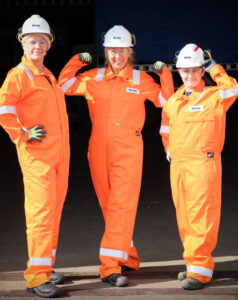Empowering Women in Skilled Trades: Strategies for Learning and Development of Leaders in the Construction Industry
 The construction industry has traditionally been male dominated, with women being significantly underrepresented especially in the skilled trades. However, there is a growing recognition of the value that women bring to the workforce, and increasing efforts are being made to promote gender equality and diversity within the industry. Learning and development leaders can play an essential role in supporting women in construction by implementing strategies to empower the female workforce.
The construction industry has traditionally been male dominated, with women being significantly underrepresented especially in the skilled trades. However, there is a growing recognition of the value that women bring to the workforce, and increasing efforts are being made to promote gender equality and diversity within the industry. Learning and development leaders can play an essential role in supporting women in construction by implementing strategies to empower the female workforce.
Although training has been identified in research across industries as one of the elements people look for when choosing a job, and ultimately a career, the construction industry has been slow at embracing it across the board. As the industry finds itself in a critical labor shortage with people retiring faster than they can recruit new hires, focusing on women has become more important than ever. However, to recruit and retain women in the skilled trades, it is essential to offer training and development programs designed specifically for their craft, and to accommodate their aspirations to learn new skills and advance their careers.
In general, young girls are not exposed to building things as often as boys are when they are growing up, and this continues as they advance through the education system. According to a 2022 Abilene Christian University doctoral dissertation by Ethel Clayton, “the national estimates for women in secondary and postsecondary construction-based education programs range between 10% and 20%.”
The National Center for Construction Education and Research (NCCER) published a white paper in 2023 based on 29 focus groups conducted with 176 trades women and a survey that reached another 770 women in construction. This research found that the majority of women get into the industry for the pay, but most stay because of the training and opportunities they receive. The women talked about the importance of this training not only for financial reward but also for the personal empowerment they felt as they progressed in the programs.
The participants stated that without training programs and information posted on project sites about how the training would benefit them, they would not have been able to learn the skills necessary to perform their jobs effectively and start advancing. In addition, the benefit to retention was evident when the women talked openly about the sense of loyalty they felt to the companies that invested in their training.
Another important type of training companies need to focus on to attract and retain women is leadership training. NCCER’s research found that 57% of the women had never had a female supervisor during their time in the industry, but 69% of them indicated they want to be in leadership roles at some point in their careers. However, in order to aspire to leadership roles in a company, individuals need to be able to see themselves in those positions. This type of visible discrepancy affects not only individual companies, but the industry as a whole.
One of the most obvious contributing factors to this disparity is that foremen, general foremen, and superintendents typically come up through the trades, so it only makes sense that with fewer women in the skilled trades, there are fewer women in site leadership positions. Recruiting more women will certainly increase the pool to choose from but without clear pathways for advancement and visibility of women in supervisory positions, skills training will not be enough.
With this in mind, companies need to develop and implement a plan to identify women early in their careers who have the leadership traits they are seeking. Interestingly, NCCER’s research found that women bring certain unique qualities to project sites, and these same characteristics are typically identified by companies as what they are looking for in future field leaders. The women and their managers stated that women tend to be better communicators than men, adhere more closely to established policies, show concern for team members and their performance, are detail-oriented, and focus more on safety. Furthermore, having a leadership track specifically for women is not only a good motivator and retention tool for the women in the field, but it is good for the company culture.
The value that women bring to the ever-evolving construction industry is undeniable, and necessary for the success of the industry as a whole. The number of women entering construction continues to grow annually, marking a significant shift toward greater diversity within the industry. As the demand for skilled workers grows, so does the need for the recruitment and retention of qualified tradeswomen. Programs and strategies that support women in the field and provide a path for professional growth is essential to enrich the industry and challenge the perception that it is an industry only for men.
Learn more about clear guidance and measurable tactics industry can apply today to improve recruitment and retention of women in construction.

